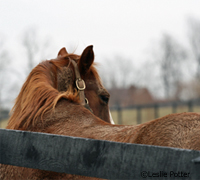 The findings from the Unwanted Horse Coalition’s Study on Contributing Factors Surrounding the Unwanted Horse Issue are now available at unwantedhorsecoalition.org. The study is the first of its kind to assess the causes and magnitude of the unwanted horse population in the United States.
The findings from the Unwanted Horse Coalition’s Study on Contributing Factors Surrounding the Unwanted Horse Issue are now available at unwantedhorsecoalition.org. The study is the first of its kind to assess the causes and magnitude of the unwanted horse population in the United States.
In light of one of the worst economic downturns in U.S. history, the economy is considered to be a significant contributor to the unwanted horse problem. The closing of the nation’s processing facilities, changes in breed demand/indiscriminate breeding, as well as the high costs of euthanasia and carcass disposal are also cited by respondents as major contributors.
Regarding placement options for unwanted horses, 63% of equine rescue/retirement facilities polled report they are at near or full capacity and, on average, turn away 38% of the horses brought to them. Capacity is clearly the issue in that as many horses stay for life at the facilities as are adopted out.
Survey respondents believe the top solutions for solving the problem of unwanted horses are to educate owners to purchase and own responsibly, increase the ability of private rescue and retirement facilities to care for unwanted horses, reopen the U.S. processing plants, and increase options and resources for euthanizing and disposing of unwanted horses.
“One of the highlights of the survey is the willingness by all respondents to resolve the unwanted horse problem,” said Tom R. Lenz, DVM, chair of the UHC. “We believe these findings will be useful in identifying common ground for all interested groups and aid us in developing solutions that will have a profound and lasting impact on the lives of unwanted horses and the horse industry at large.”
The survey was conducted from November 2008 to January 2009 by an independent market research company. More than 23,000 horse owners, equine industry stakeholders and nonhorse owners participated. For more information, contact Julia Andersen, UHC director, at jandersen@horsecouncil.org.






Interesting!
Isure hope that changes come to pass as a result of the inf gathered.
I like the horse in the picture!
None of the horses are unwanted. I want them all but I can’t afford it.
thank you for this informative article.
It is sad that even though your organization is for “helping horses” it almost seems to be an advocate for slaughtering them. The answer and the only answer is STOP CREATING UNWANTED HORSES! CARE FOR THE ONES WE HAVE!!!!!!! STOP BACK YARD BREEDING! EDUCATE HORSE OWNERS AND HORSE BUYERS! REGISTER AND YES YES YES CHARGE FOR HAVING STALLIONS (THUS CREATING COUNTY FUNDS FOR DEALING WITH “UNWANTED ANIMALS”)!!!! ENFORCE PROPERTY ZONING! TRAINERS – BE REAL “TRAINERS” AND MATCH APPROPRIATE HORSES WITH RIDERS!!!!!!!!! COMMUNITIES_ START WORKING TOGETHER TO CREATE RESOURCES TO ASSIST IN AVOIDING THE “UNWANTED HORSE”! COME ON PEOPLE………. ARE THEY LIVESTOCK OR ARE THEY FAMILY????????????? I FEEL SO LUCKY AND BLESSED TO HAVE MY OLD RETIRED BROOD MARE IN MY LIFE, AND SHE WILL BE WITH ME UNTIL SHE DIES. LET’S EVERYONE TAKE THE SAME KIND OF COMMITMENT AND ENJOY THE SAME REWORDS!
thank you for this information